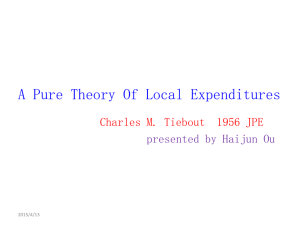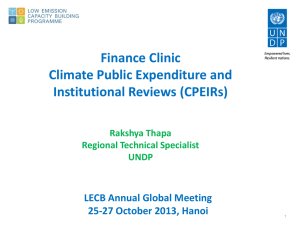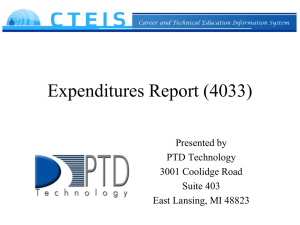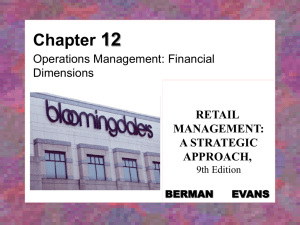Tax Expenditures – William H. Batt - The Foundation for Fiscal Studies
advertisement
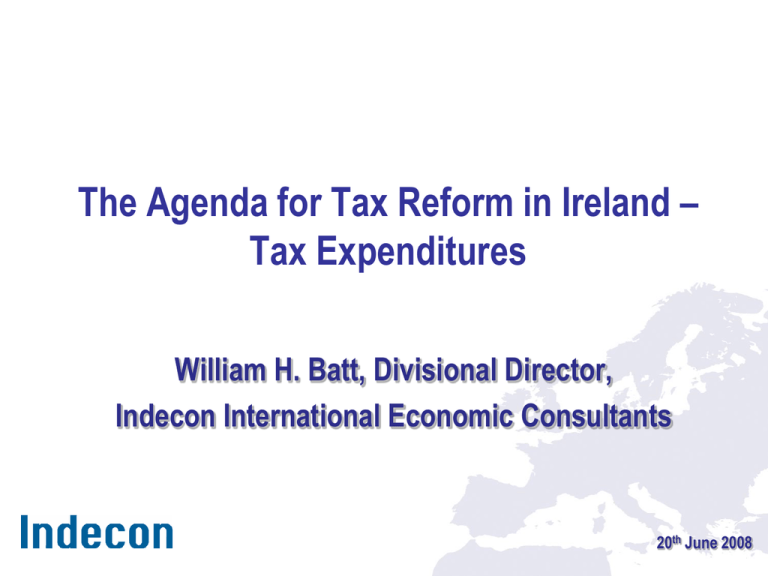
The Agenda for Tax Reform in Ireland – Tax Expenditures William H. Batt, Divisional Director, Indecon International Economic Consultants 20th June 2008 Presentation Structure Introduction Description of Tax Expenditures Issues re Review of Tax Expenditures Examples and Outcomes from Indecon Review Concluding Remarks 2 Introduction Context for Commission’s work expenditures: in area of tax » Proliferation of various tax incentive mechanisms and schemes over long period » Increased focus on need to demonstrate value for money in usage of public resources » Absence – until recently – of timely information on usage and costs relating to different tax expenditures » Continued scarcity of information on outputs/benefits of tax expenditures 3 Description of Tax Expenditures Definition of tax expenditures: “A tax expenditure can be defined as a transfer of public resources that is achieved by reducing tax obligations with respect to a benchmark tax, rather than by a direct expenditure” (OECD, 2003) Tax expenditures, as distinct from public expenditures, may take a variety of forms, including: »Exemptions »Allowances »Credits »Reliefs, including tax rate reductions »Tax deferrals 4 Description of Tax Expenditures A wide range of different tax expenditure schemes/mechanisms have been employed in Ireland Some (limited) examples of schemes/mechanisms include: » ‘Property-based’ and sector-specific taxation incentive schemes, e.g. childcare facility scheme » ‘Area-based’ taxation incentive schemes – e.g. Section 23 » Tax credits – e.g. R&D credits » Pension contribution relief 5 Issues re Review of Tax Expenditures Introduction and operation of various tax expenditures over time in Ireland have reflected variety of policy contexts and rationales Tax expenditures should be evaluated similarly to other public expenditure programmes => value for money imperative and both represent a cost to the taxpayer Evaluation/review of tax expenditures should therefore follow Department of Finance’s guidance on evaluation of expenditure programmes: » Relevance » Rationale » Effectiveness » Efficiency » Impact 6 Issues re Review of Tax Expenditures Particular challenges involved in evaluation/review of tax expenditures: » Tax expenditures are passive in nature » Full costs of standard public expenditures typically known ex ante; costs of tax expenditures are only known ex post => issue of take-up impacting on costs » Issue of information – absence, until recent change in tax return requirements, of timely information on costs relating to different tax expenditures » Very little information available on outputs/benefits of tax expenditures 7 Examples and Outcomes from Indecon Review Instructive to consider evaluation of tax expenditures by reference to previous review work in this area Detailed review of property-based tax incentive schemes was completed by Indecon for Department of Finance This review considered 11 different property-based schemes across number of sectors/areas including tourism, medical, 3rd-level education, childcare sectors 8 Examples and Outcomes from Indecon Review Useful, for purposes of this presentation, to focus on 2 examples of schemes reviewed by Indecon, namely: » Capital allowances for Hotels; and » Capital allowances for Childcare Facilities 9 Examples and Outcomes from Indecon Review Key components of Indecon’s approach to review are set out below Approach to and Key Components of Indecon Review Quantification of Level of Activity, Investment/Capital Expenditures and Exchequer Costs Evaluation of Gross Economic Costs and Benefits Adjustments for Deadweight, Displacement and Opportunity Cost of Resources Utilised Analysis of Distributional Impacts of Benefits Assessment of Alternatives and/or Refinements to Schemes 10 Examples and Outcomes from Indecon Review Capital allowances for Hotels – key features: » Capital expenditure incurred up to 31 December 2004 on any building or structure used as a hotel or holiday camp qualified for capital allowances » Allowances of 15% of expenditures for first 6 years and 10% in seventh year » Reduction to 4% per annum over 25 years on expenditure incurred after December 2004 » Finance Act 2004 provided extension of transitional arrangements from December 2004 to July 2006 » Capital allowances ring-fenced and could be offset only against rental income in case of individual, passive investors 11 Examples and Outcomes from Indecon Review Number of significant changes in hotel sector in Ireland: » Considerable increase in room supply and quality since mid-1990s (see overleaf), particularly in 4* category » Substantial increase in planning application activity coincident with incentive scheme » Room and bed utilisation rates have fallen, however, since 2000 » Average size of hotels has increased » Evidence that incentive scheme has had significant differential impact on supply and majority of hoteliers believe scheme has contributed to over-supply in sector 12 Examples and Outcomes from Indecon Review Total Number of Hotel Rooms - 1996-2005 120,000 100,000 80,000 60,000 40,000 20,000 0 1996 1999 2002 2005 Source: Gulliver database 13 Examples and Outcomes from Indecon Review Estimated Total Eligible Capital Expenditure on Hotels and Holiday Camps under the Tax Incentive Scheme Detail Estimated Value - € Million Total Cumulative Capital Expenditure – 2001-2005 664.4 Forecast for Future Capital Expenditure 977.0 Source: Indecon Calculations 14 Examples and Outcomes from Indecon Review Exchequer Costs - Estimated Tax Revenue Foregone under the Tax Incentive Scheme for Hotels/Holiday Camps Estimate € Million Capital Expenditure to Date 664.4 Est. Additional/Future Capital Expenditure 977.0 Gross Tax Revenue Foregone 195.8 Estimated Economic Benefits (adjusted for opportunity cost of resources) 41.7 Tax contribution adjusted for Indirect Tax Revenues 75.2 Net Tax Revenue Foregone 120.5 Net Tax Revenue Foregone – adjusted for Deadweight 125.0 Source: Indecon calculations 15 Examples and Outcomes from Indecon Review Capital allowances for Childcare Facilities: » Allowances available for expenditures on or after 2 December 1998 on construction, extension or refurbishment of approved childcare facilities » 100% relief available in Year 1 or at 15% per annum for first 6 years and 10% in Year 7 » Clawback provision if building ceases to be used as a childcare facility within 10 years » No termination date for incurring qualifying expenditure on this relief 16 Examples and Outcomes from Indecon Review Capital allowances for Childcare Facilities – Activity: » Evidence of positive differential impact of tax relief scheme on supply of childcare places (+37% between 1999 and 2004) » However, demand has outstripped supply and childcare costs have continued to increase 17 Average Cost of Places - € per Week Examples and Outcomes from Indecon Review €139 140 €126 120 100 €95 €85 80 60 40 20 0 2000 2005 Childcare Providers that have availed of the tax incentive scheme over the past 5 years Childcare Providers that have not availed of the tax incentive scheme over the past 5 years 18 Examples and Outcomes from Indecon Review Estimated Total Eligible Capital Expenditure on Childcare Facilities under the Tax Incentive Scheme Detail Estimated Value € Million Total Cumulative Capital Expenditure – 2001-2005 30.7 Forecast for Future Capital Expenditure (based on planning applications in 2005) 21.2 Source: Indecon Calculations 19 Examples and Outcomes from Indecon Review Exchequer Costs - Estimated Tax Revenue Foregone under the Tax Incentive Scheme for Childcare Facilities Estimate € Million Capital Expenditure to Date 30.7 Est. Additional/Future Capital Expenditure 21.2 Gross Tax Revenue Foregone 8.6 Estimated Economic Benefits (adjusted for opportunity cost of resources) 7.7 Tax contribution adjusted for Indirect Tax Revenues 3.5 Net Tax Revenue Foregone 5.1 Net Tax Revenue Foregone – adjusted for Deadweight 5.7 Source: Indecon calculations 20 Examples and Outcomes from Indecon Review Number of general policy recommendations for future operation of property-based schemes on were issued: » Increase requirements for disclosure of key information to Revenue and the Exchequer by investors/promoters » Decision on any new incentive schemes should be informed by full appraisal of likely costs and benefits » Option of direct public expenditure rather than tax reliefs should be considered » Need to specify defined lifespan for any schemes introduced » Consider potential cap on total annual allowances which can be claimed by any one individual (distributional impacts) 21 Examples and Outcomes from Indecon Review Specific recommendations re Hotels and Childcare schemes » “There should be no further extension of capital allowances for hotels and holiday camps for projects which have not lodged a full and valid planning application before 31 December 2004” » “Capital allowances for childcare facilities should continue subject to certain amendments” 22 Concluding Remarks Large number of tax expenditure-based schemes/mechanisms have operated in the State Increasing emphasis on demonstrating value for money and absence of information costs have prompted review and evaluation Overall, while many schemes have generated benefits, Indecon analysis indicated that schemes, with limited exceptions, have served their purpose Key issue of whether direct public supports would, in majority of cases, represent more efficient, effective and targeted usage of scarce resources 23
